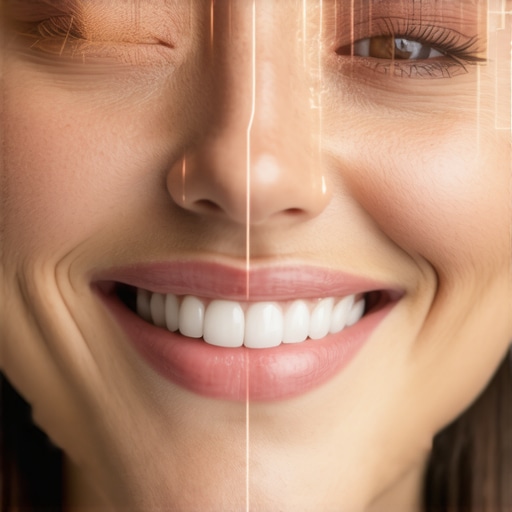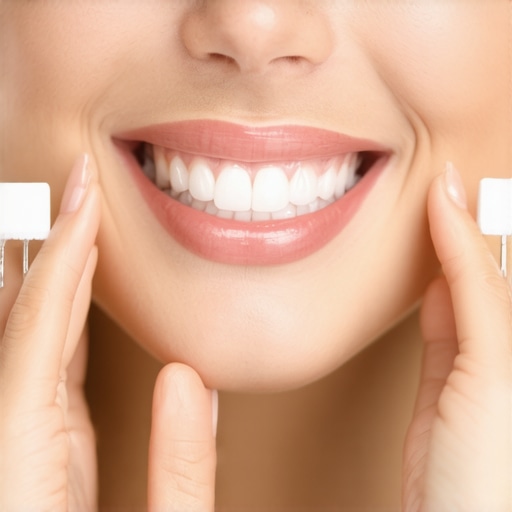Unlocking the Synergy Between Invisalign and Teeth Whitening for Optimal Smile Transformation
In the rapidly evolving landscape of cosmetic dentistry, integrating orthodontic solutions like Invisalign with professional teeth whitening techniques offers a comprehensive pathway to achieving a radiant, aligned smile. As dental professionals become increasingly adept at combining these modalities, understanding the underlying principles and nuanced applications becomes essential for delivering exceptional results in 2024.
How Does the Integration of Invisalign and Teeth Whitening Elevate Smile Aesthetics?
The concurrent use of clear aligners and whitening treatments optimizes both alignment and brightness, addressing common aesthetic concerns with a unified approach. This synergy not only enhances patient satisfaction but also minimizes treatment duration by sequencing procedures strategically, often with whitening scheduled post-aligner adjustments to maximize the luminosity of newly aligned teeth.
What Are the Critical Considerations for Timing and Material Compatibility in Combined Cosmetic Treatments?
Timing is paramount; performing whitening prior to or after orthodontic correction requires careful planning to prevent uneven coloration or surface damage. Furthermore, selecting compatible whitening agents and materials—such as non-porous veneers or composite restorations—ensures that the aesthetic improvements are durable and harmonious. For detailed insights, consult best cosmetic enhancement strategies.
The Role of Patient-Specific Factors in Customizing Smile Makeover Protocols
Each patient presents unique anatomical and aesthetic profiles, necessitating personalized protocols that consider enamel health, existing restorations, and oral hygiene habits. Advanced digital smile design tools facilitate precise planning, allowing clinicians to simulate the combined effects of Invisalign and whitening, thereby setting realistic expectations and ensuring comprehensive care.
Leveraging the Latest Innovations: How Emerging Technologies are Shaping 2024’s Smile Makeover Paradigm
Recent technological advancements—such as AI-driven treatment planning and enhanced bleaching agents—are transforming how practitioners approach combined orthodontic and whitening procedures. For instance, integrated smile solutions now offer faster, more predictable outcomes, aligning with patient expectations for minimally invasive, high-impact transformations.
What Future Trends Will Define the Next Era of Smile Makeovers?
Looking ahead, the integration of biomimetic materials and personalized medicine will further refine the collaborative use of Invisalign and whitening. As research from the American Academy of Cosmetic Dentistry emphasizes, a multidisciplinary approach—combining orthodontics, whitening, veneers, and digital planning—will become the gold standard for comprehensive smile rejuvenation.
For professionals seeking to deepen their expertise or contribute insights, exploring advanced case studies and peer-reviewed publications is highly recommended. Additionally, engaging with specialized forums can foster innovative ideas and best practices in this dynamic field. To begin your journey, visit our contact page.
Harnessing Cutting-Edge Technologies: Elevate Your Smile Transformation Strategy
As the field of cosmetic dentistry continues to innovate, integrating advanced digital tools and biomimetic materials can significantly enhance the outcomes of combined Invisalign and teeth whitening treatments. Digital smile design software, for instance, empowers clinicians to visualize and tailor comprehensive treatment plans with unparalleled precision, aligning patient expectations with achievable results. These tools facilitate a virtual preview of how whitening and orthodontics will harmonize, reducing uncertainties and increasing patient satisfaction.
What Are the Nuances of Material Compatibility in Complex Smile Makeovers?
When combining whitening with restorative or orthodontic procedures, understanding material compatibility is crucial. For example, ceramic veneers and composite restorations vary in their response to bleaching agents; some materials may stain or degrade if exposed to certain whitening treatments. A nuanced approach involves selecting non-porous, stain-resistant materials and scheduling procedures strategically—for example, performing whitening before veneer placement to ensure uniform brightness and longevity. For insights into selecting appropriate materials, consult best cosmetic enhancement strategies.
How Can I Customize a Smile Makeover That Aligns with the Patient’s Unique Biological and Aesthetic Profile?
Every patient’s oral anatomy, enamel health, and aesthetic preferences are distinct, necessitating a personalized approach. Advanced diagnostic tools, including 3D imaging and digital mock-ups, enable clinicians to simulate various treatment scenarios, ensuring the final outcome complements the patient’s facial features and natural tooth morphology. This personalized planning not only enhances aesthetic success but also minimizes risks associated with over- or under-correction. For comprehensive guidance on customizing treatments, explore our family dentistry tips.
Integrating Biomimetic Materials and Personalized Medicine: The Future of Smile Rejuvenation
The future of smile makeovers lies in biomimetic materials that replicate natural tooth properties, ensuring durability and harmony with surrounding tissues. Coupled with personalized medicine—using genetic and microbiome insights—these innovations promise more predictable, long-lasting results. For instance, emerging biocompatible composites and growth factors can accelerate tissue regeneration, reducing treatment time and improving overall outcomes. As research from the American Academy of Cosmetic Dentistry highlights, a multidisciplinary approach combining orthodontics, whitening, and regenerative materials will set new standards in aesthetic dentistry (American Academy of Cosmetic Dentistry).
To deepen your expertise in these evolving areas, consider engaging with peer-reviewed journals and professional forums dedicated to digital dentistry and biomaterials. For personalized advice or to discuss your next case, visit our contact page.
Harnessing the Power of Biomimetic Materials for Seamless Smile Rejuvenation
As cosmetic dentistry evolves, the adoption of biomimetic materials—designed to imitate natural tooth properties—has revolutionized the way clinicians approach smile makeovers. These advanced composites and ceramics not only enhance the durability and aesthetic harmony of restorations but also promote biological compatibility, reducing adverse reactions and improving long-term outcomes. For instance, biomimetic ceramics like silica-based composites exhibit similar translucency and flexural strength to natural enamel, facilitating more lifelike restorations that integrate seamlessly with existing dentition.
Moreover, ongoing research into nanotechnology-enabled biomimetic materials offers promising avenues for regenerative procedures, such as stimulating enamel remineralization or facilitating tissue regeneration in periodontal therapies. This convergence of material science and biological mimicry underscores a paradigm shift toward truly holistic smile rehabilitation, emphasizing not just appearance but also the health and functionality of oral tissues.

Digital Smile Design and AI-Driven Treatment Planning: Transforming Customization and Precision
The integration of sophisticated digital tools, including AI-driven treatment planning software, enables clinicians to create highly personalized and predictable smile makeovers. Digital smile design allows for comprehensive visualization, enabling patients to preview the anticipated results before any procedure begins. When combined with AI algorithms that analyze facial symmetry, tooth proportions, and dynamic facial expressions, these systems can generate optimized treatment plans that consider individual biological and aesthetic nuances.
For example, AI can assist in selecting ideal tooth shapes, colors, and alignment strategies based on vast datasets, reducing uncertainties and enhancing clinician confidence. The use of virtual reality and augmented reality further enhances patient engagement, fostering collaboration and ensuring that aesthetic goals align with patient expectations. As these technologies mature, they will increasingly facilitate minimally invasive procedures with maximal precision, ultimately elevating treatment efficacy and patient satisfaction.
Nuances of Material Compatibility in Complex Restorative and Orthodontic Integrations
In advanced smile makeovers, understanding the interaction between various restorative materials and whitening agents is critical. For example, porcelain veneers, composite restorations, and resin-based composites differ significantly in their porosity and stain resistance, influencing their response to bleaching protocols. Porcelain, being non-porous, generally withstands whitening treatments well; however, composite restorations may stain or degrade if exposed to certain bleaching agents.
Hence, strategic planning involves performing whitening procedures prior to restorative placements or selecting stain-resistant, non-porous materials for restorations. Additionally, the use of low-concentration, carbamide peroxide-based bleaching agents minimizes surface damage while achieving desired whitening effects. Clinicians must stay abreast of emerging research, such as the findings published in the Journal of Esthetic and Restorative Dentistry, which detail material-specific responses to various whitening protocols, ensuring longevity and aesthetic harmony in complex cases.
Exploring the Synergy of Innovative Materials in Smile Makeovers
The evolution of biomimetic materials continues to revolutionize aesthetic dentistry, enabling clinicians to craft restorations that mimic natural enamel’s translucency, strength, and biological compatibility. For example, silica-based composites with nanotechnology enhancements offer exceptional aesthetic integration, reducing the risk of staining and ensuring longevity when combined with whitening protocols.
How Do Digital and Biological Advances Converge to Personalize Smile Rejuvenation?
Fusing digital smile design with insights from genetic and microbiome research allows for highly tailored treatments. This convergence facilitates the development of personalized protocols that consider individual tissue responses, enamel resilience, and aesthetic goals, ultimately leading to more predictable and harmonious outcomes.
What Cutting-Edge Technologies Are Pioneering the Next Generation of Smile Makeovers?
Emerging innovations such as augmented reality for patient visualization, AI-driven predictive modeling, and bioprinting of custom biomimetic restorations are setting new standards in aesthetic dentistry. These tools enable meticulous planning and execution, reducing chair time and enhancing patient satisfaction. For comprehensive insights into these advancements, consult the latest publications in the Journal of Cosmetic Dentistry.
Can Combining Regenerative Therapies with Cosmetic Procedures Transform Outcomes?
Integrating regenerative approaches, like growth factor applications and tissue engineering, with traditional cosmetic protocols holds promise for enhancing tissue health and stability. For instance, using platelet-rich plasma (PRP) can stimulate periodontal regeneration, ensuring that aesthetic improvements are supported by underlying biological health, thus extending the longevity of smile enhancements.
< >
>
How Do Material Choices Influence Long-Term Aesthetic and Functional Stability?
Strategic selection of restorative materials—such as non-porous, stain-resistant ceramics and advanced composites—directly impacts the durability and aesthetic longevity of smile makeovers. Recent studies emphasize the importance of matching material properties to specific clinical scenarios, especially in cases involving combined whitening and restorative procedures, to prevent staining, wear, or degradation over time.
For practitioners eager to refine their material selection strategies, the American Academy of Cosmetic Dentistry provides invaluable resources and peer-reviewed guidelines.
Expert Insights & Advanced Considerations
1. Embrace Digital Integration for Precision Outcomes
Utilizing AI-driven digital smile design and treatment planning tools allows clinicians to customize smile makeovers with unparalleled accuracy, reducing uncertainties and enhancing patient satisfaction. These technologies facilitate a virtual preview of aesthetic results, aligning expectations with achievable outcomes.
2. Prioritize Material Compatibility to Maximize Longevity
Strategic selection of restorative materials—such as non-porous ceramics and stain-resistant composites—is essential when combining whitening with restorations. Planning procedures to optimize material response ensures long-term aesthetic stability and functional durability.
3. Incorporate Regenerative Approaches for Sustainable Results
Integrating regenerative therapies like growth factor applications and tissue engineering enhances tissue health and stability, extending the lifespan of aesthetic improvements. These biological adjuncts are increasingly pivotal in comprehensive smile rejuvenation.
4. Leverage Emerging Biomimetic Materials
Biomimetic materials that imitate natural tooth properties are advancing restorative excellence, offering improved translucency, strength, and biocompatibility. Their use signifies a shift toward holistic, durable smile makeovers that harmonize form and function.
5. Stay Informed with Peer-Reviewed Research and Professional Forums
Engaging with the latest publications and expert communities fosters continuous learning and innovative practice. Resources such as the American Academy of Cosmetic Dentistry provide invaluable insights into cutting-edge developments.
Curated Expert Resources
- American Academy of Cosmetic Dentistry: A premier source for peer-reviewed research, clinical guidelines, and continuing education on cosmetic procedures.
- Journal of Esthetic and Restorative Dentistry: Offers detailed studies on material responses, procedural innovations, and case analyses relevant to complex smile makeovers.
- Digital Dentistry Society: Provides insights into the latest digital tools, AI applications, and virtual planning techniques transforming aesthetic dentistry.
- Peer-Reviewed Publications and Professional Forums: Platforms for exchanging advanced knowledge, discussing case challenges, and exploring emerging technologies.
Final Expert Perspective
In 2024, the integration of cutting-edge technologies, biomimetic materials, and regenerative therapies is redefining the landscape of smile makeovers. Achieving optimal results demands a sophisticated understanding of material science, digital planning, and biological responses—areas where continuous professional development is crucial. For practitioners committed to delivering superior aesthetic and functional outcomes, embracing these innovations not only elevates clinical excellence but also enhances patient trust and satisfaction. Explore these resources and tools to deepen your expertise and contribute meaningfully to the future of aesthetic dentistry. To share your insights or seek personalized advice, visit our contact page.

